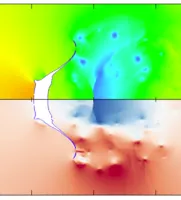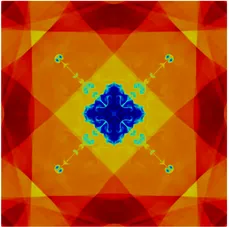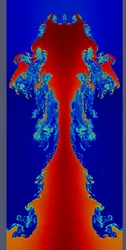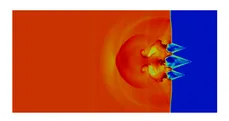
NANOSHOCK - Manufacturing Shock Interactions for Innovative Nanoscale Processes

Research activities
We develop accurate and computationally efficient algorithms to simulate complex multiphysics flow problems ranging from kidney-stone lithotripsy and drug delivery to advanced aircraft design.
In the following, we briefly present some examples of your current research topics:
Liquid water drop explosion by numerical simulation

We investigate the initial stages of shock-driven explosion of liquid water microdrops numerically using ALPACA. We solve the axisymmetric Euler equations on a high-resolution grid and use the level-set based conservative interface-interaction method to model multiphase phenomena including phase transition. Our simulations show accurate predictions of the initial stages of the violent liquid drop explosion dynamics as compared to a recent reference experiment (Stan et al., Nature Physics 12, 966 (2016) and Stan et al., J. Phys. Chem. Lett. 7, 2055 (2016)).
PhD student: Thomas Paula
Direct numerical simulation of aerodynamic fragmentation

Aerodynamic fragmentation describes the breakup of a large drop into multiple smaller droplets. It is an important physical mechanism occurring in many technical application, ranging from liquid fuel combustion to pharmaceutical manufacturing or spray painting. Our goal is to investigate the underlying physical phenomena occurring during this process. We solve the three-dimensional Euler equations with a characteristic-based solver and apply a level-set based conservative interface-interaction method. Our preliminary 2D and 3D results agree well with previous experimental and numerical results. In the future, we plan to conduct highly resolved 3D simulations and evaluate the influence of physical phenomena like capillary forces or viscosity on the breakup process.
This project is partly funded by Deutsche Forschungsgesellschaft (DFG, Projektnummer 277161739).
PhD student: Jakob Kaiser
High-resolution discretization schemes
We continuously develop and improve our numerical methods and compute capabilities to simulate complex physical problems with highest spatial resolution and computational efficiency. Interestingly, solving the inviscid and per se unstable Euler equations using spatial schemes with increasingly high order is subject to new challenges. Due to the fact that numerical dissipation no longer suppresses the effect of floating-point inaccuracies, symmetric test cases like an implosion problem or the Rayleigh-Taylor-Instability tend to loose symmetry. We improved our numerical algorithms and actual implementations to ensure perfect symmetry of low-dissipative test problems.
PhD student: Nico Fleischmann
Grid-aligned shock instability
Modern low-dissipative shock-capturing finite-volume methods enable highly sophisticated numerical investigations that give unique insight into complex flow physics. Nevertheless, these methods appear to fail spectacularly on certain occasions involving high Mach-number shock waves moving aligned to a Cartesian grid. This flaw especially prevents an accurate computation of hypersonic flows. We are investigating this phenomenon in detail in order to understand the underlying principle and to improve our numerical methods.
PhD student: Nico Fleischmann



